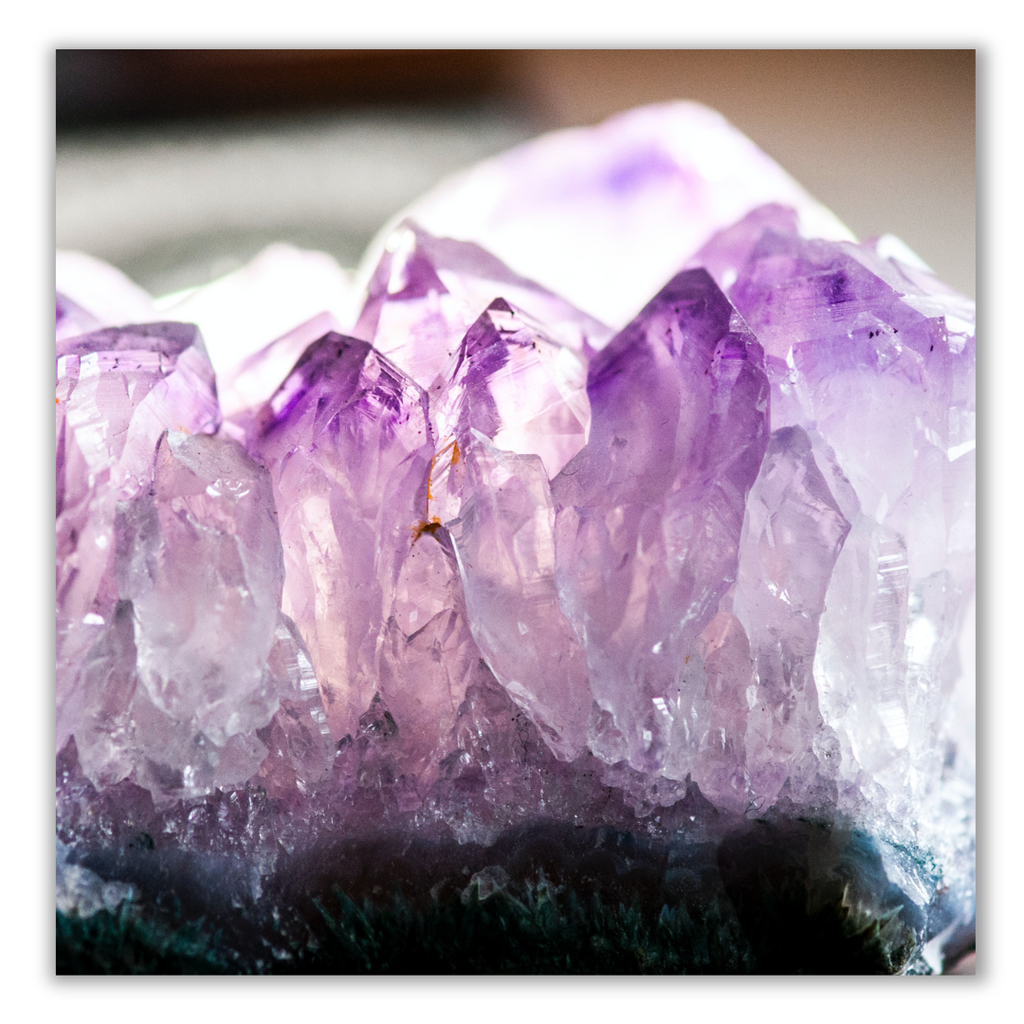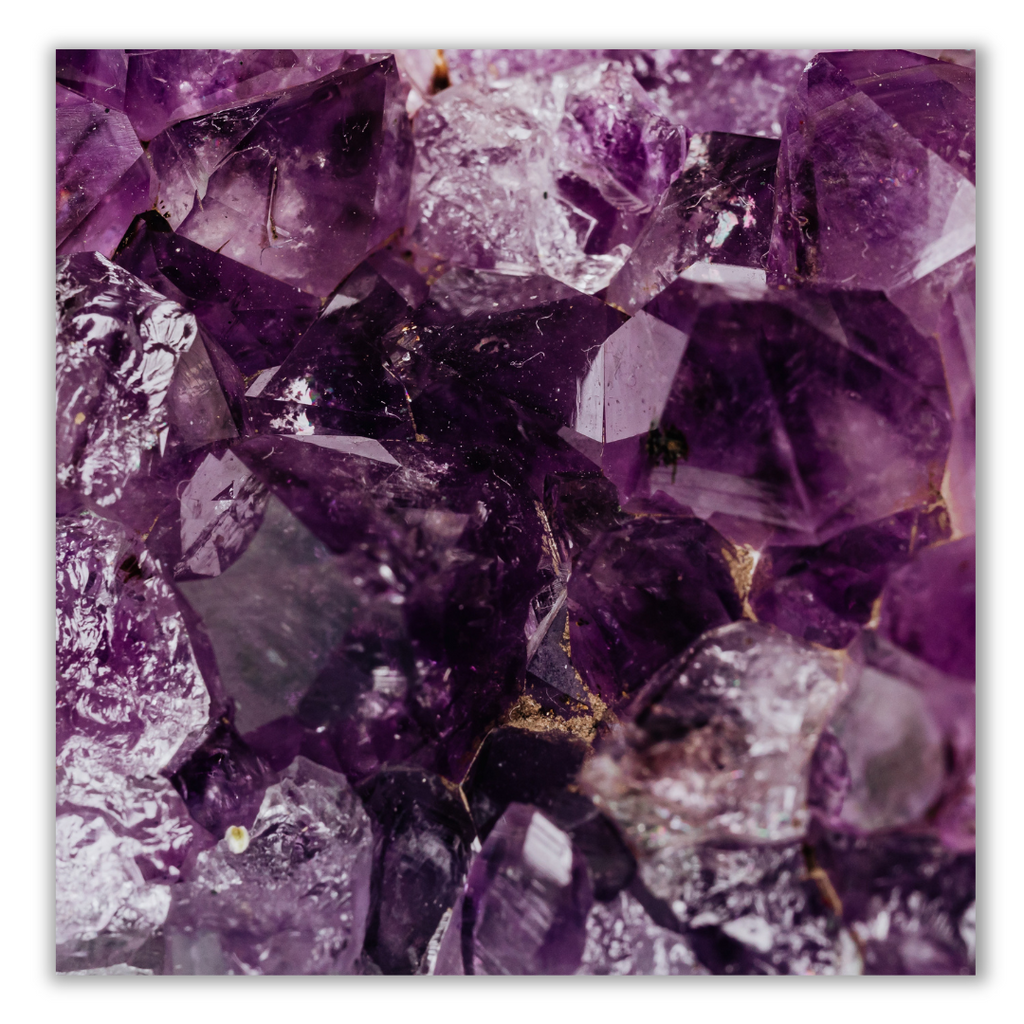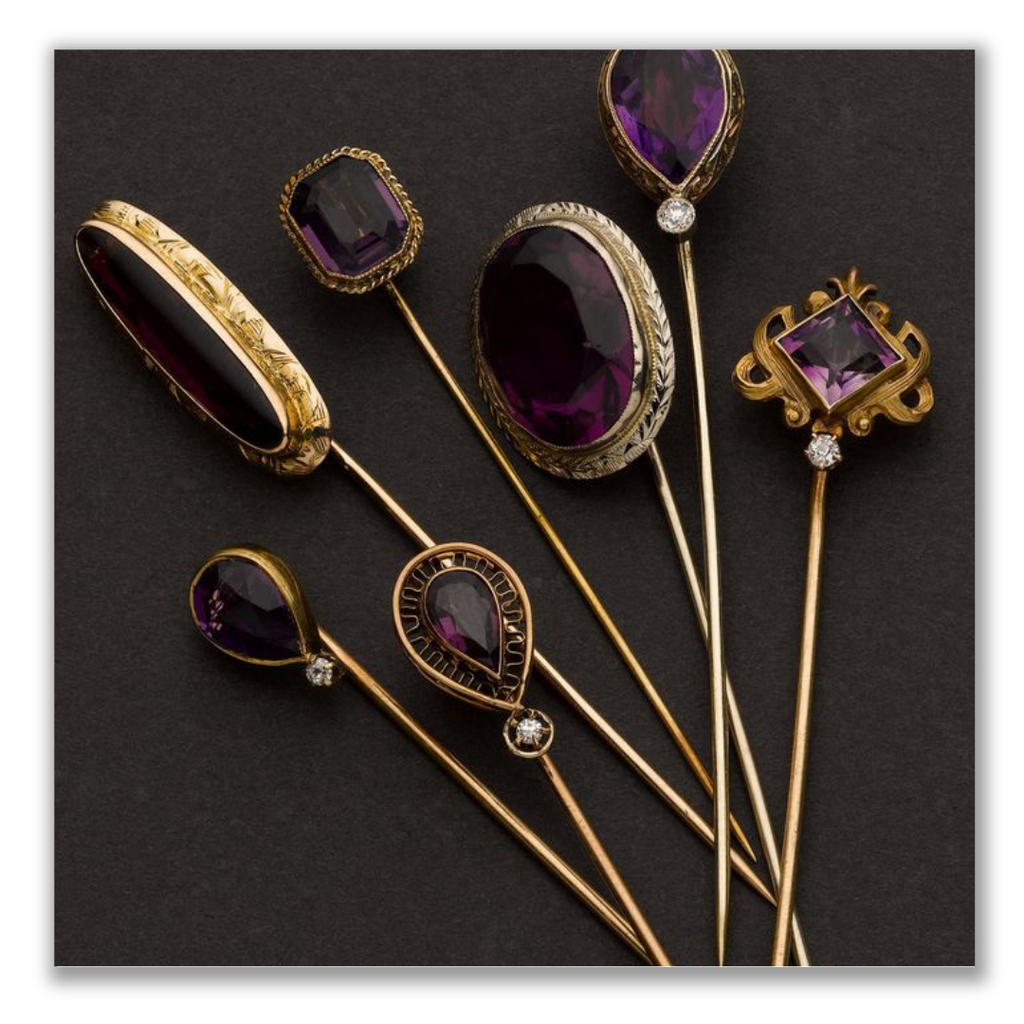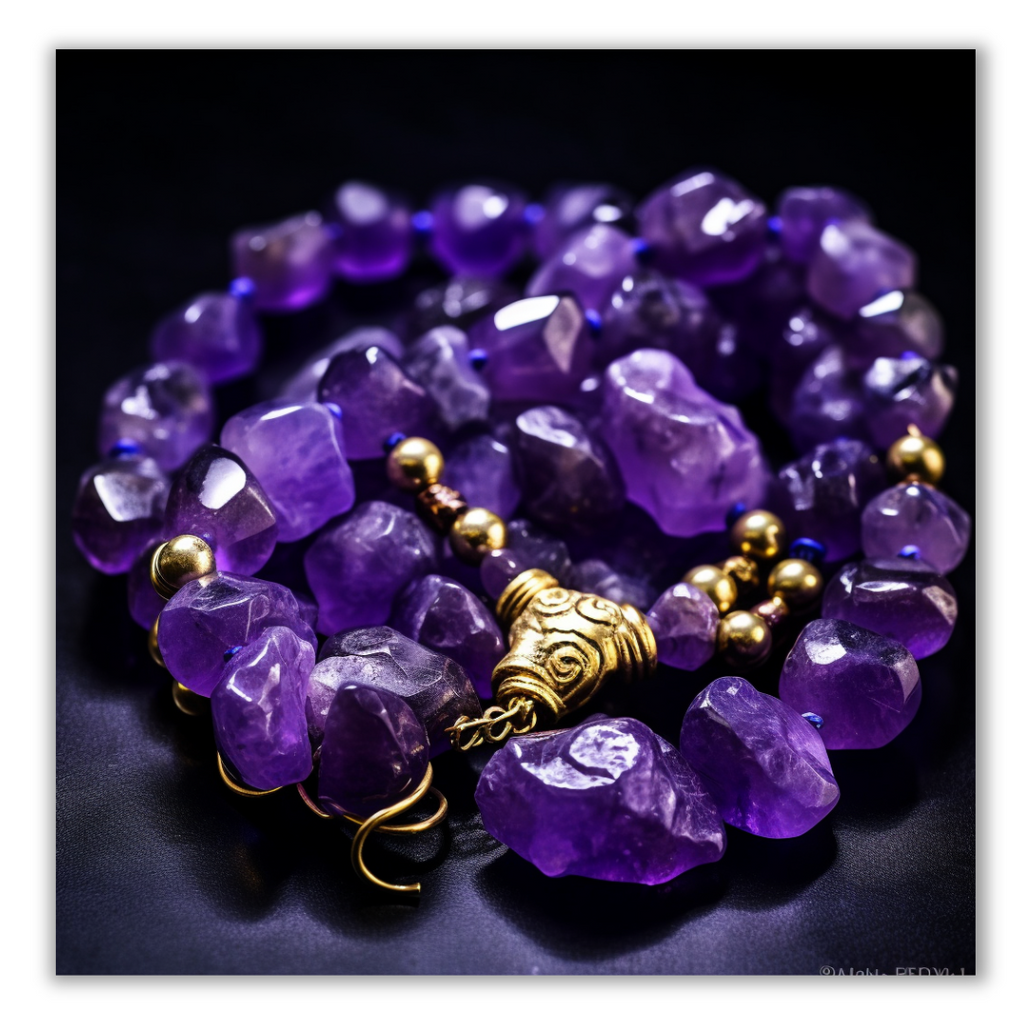
Exploring the Enchanting Amethyst

Welcome to our exploration of the captivating birthstone for the month of February: the exquisite amethyst. In this comprehensive guide, we'll dive into the rich history, symbolism, properties, and significance of this enchanting gemstone that holds a special place in the hearts of those born in the second month of the year.

Introduction to February's Birthstone: Amethyst:
Amethyst, a captivating and regal gemstone, takes center stage as February's birthstone. Known for its enchanting purple hues and storied history, amethyst has held a special place in cultures across the world for centuries. Let's delve into the fascinating world of amethyst, exploring its origins, symbolism, and the alluring qualities that make it a treasured gemstone.
Elegant Shades of Purple:

Colors and Shades of Amethyst
Amethyst is renowned for its stunning range of purple shades, from delicate lilacs to deep, velvety purples. The gemstone's color is primarily attributed to trace amounts of iron and aluminum within its crystal structure. This distinctive hue lends amethyst a sense of elegance and mystique that has captivated jewelry enthusiasts and collectors throughout history.
A Journey Through Time:

Edwardian Amethyst Diamond and Pearl Pin
The history of amethyst dates back to ancient civilizations that prized its beauty and believed in its mystical properties. Here are some highlights of its historical journey:

-
Ancient Egypt: Amethyst was used in jewelry, amulets, and even carved into figurines by the ancient Egyptians. It was associated with protection and held spiritual significance.
-
Greek Mythology: The word "amethyst" is derived from the Greek word "amethystos," meaning "not intoxicated." Legend has it that this gemstone was believed to prevent drunkenness and was associated with the god Dionysus.
-
Royalty and Power: Amethyst has long been associated with royalty and power. In the Middle Ages, it was considered a gemstone of the elite and was often worn by monarchs and church officials.
Spiritual and Healing Properties: Throughout history, amethyst has been revered for its metaphysical qualities and healing properties:
-
Clarity and Calm: Amethyst is often associated with enhancing mental clarity and promoting a sense of calmness. It's believed to aid in stress relief and emotional balance.
-
Spiritual Connection: This gemstone is also considered a stone of spiritual growth and enlightenment. It's said to facilitate meditation, enhance intuition, and deepen one's connection to the spiritual realm.
Modern Significance:

Victorian Style Amethyst and Gold Necklace transformed
In contemporary times, amethyst continues to be cherished for its beauty and symbolism. As February's birthstone, it carries special meaning for those born in this month. Amethyst is believed to bring clarity, strength, and balance to their lives, making it a thoughtful and personalized gift choice.
Variety and Versatility: Amethyst's availability in a range of sizes and cuts makes it versatile for various jewelry designs. From solitaire rings and pendant necklaces to intricate earrings and bracelets, amethyst's allure can be showcased in diverse settings.

Historical Significance and Legends:

Amethyst, with its royal purple hues and fascinating history, holds a significant place in the tapestry of human culture. From ancient legends to its association with royalty, this gemstone has captivated hearts and minds throughout the ages. Let's delve into the historical significance and captivating legends that surround amethyst:
Ancient Symbolism:

Greek Amethyst Gemstone Ring
Amethyst's historical roots can be traced back to various ancient civilizations, each attributing unique meanings and qualities to this gemstone:
-
Egypt: In ancient Egypt, amethyst was treasured for its deep purple color, which symbolized luxury and power. It was often used in jewelry, carved into amulets, and incorporated into the belongings of royalty and the elite.
-
Greek Mythology: One of the most enduring legends associated with amethyst originates from Greek mythology. The myth of Dionysus and Amethystos tells of a young maiden named Amethystos who was turned into a clear quartz by the goddess Artemis to protect her from the advances of Dionysus, the god of wine. Dionysus, in remorse for his actions, poured wine over the crystal, thus giving it its purple hue. This tale led to the belief that amethyst could prevent intoxication and promote sobriety.
Regal Gemstone:

Amethyst sculpture by Asta J.
Throughout history, amethyst has been associated with royalty and luxury.
Middle Ages:

Italian Ring with Intaglio of Sabina c_ 1800
Amethyst gained prominence during the Middle Ages when it was believed to possess protective and healing properties. It was often worn by monarchs, church officials, and nobles as a symbol of power and prestige.
Russian Royalty:

Amethyst's allure extended to Russian royalty, where it was incorporated into elaborate jewelry pieces and crown jewels. The Russian Empress Catherine the Great was particularly fond of amethyst.
Spiritual and Healing Beliefs:
Amethyst's symbolism also extends to spiritual and metaphysical beliefs:
Spiritual Enlightenment:
Amethyst has been considered a stone of spiritual enlightenment and transformation. It's believed to enhance meditation, intuition, and a connection to higher realms.
Healing Properties:
In crystal healing practices, amethyst is thought to promote emotional balance, reduce stress, and aid in calming the mind. It's often associated with the third eye and crown chakras, which are believed to govern intuition and higher consciousness.
Modern Relevance:

In the modern world, amethyst continues to hold a special place as a gemstone of significance and allure. Its historical and spiritual associations make it a popular choice for individuals seeking both beauty and deeper meaning in their jewelry.

Properties and Characteristics of Amethyst:

Amethyst, with its captivating purple hues and fascinating history, possesses a unique set of properties and characteristics that contribute to its enduring appeal. From its physical attributes to its metaphysical qualities, amethyst's allure is a result of its inherent nature:
Color and Clarity: Amethyst's signature color ranges from pale lilac to deep violet and can even display reddish or blueish undertones. The intensity of the color can vary based on the iron content within the gemstone. The most prized amethysts exhibit a rich, saturated purple color with excellent clarity, allowing light to pass through and create a mesmerizing play of light.
Crystal Structure: Amethyst belongs to the quartz family and shares the same crystal structure as other quartz varieties. It forms in hexagonal prisms and often has well-defined facets that contribute to its brilliance. Its transparency allows it to be expertly cut into various shapes and sizes, making it a versatile choice for jewelry.
Hardness and Durability: Amethyst ranks 7 on the Mohs scale of hardness, indicating its relative resistance to scratching and abrasion. While not as hard as diamonds, sapphires, or rubies, amethyst's durability makes it suitable for a wide range of jewelry applications. However, like all gemstones, it can still be damaged by hard blows or harsh chemicals.
Inclusions and Varieties: While amethyst is generally prized for its clarity, it can contain various inclusions and features. Some inclusions, like "feathers" or "needles," can enhance the gem's visual interest and provide a unique fingerprint of its formation. There are also rarer varieties of amethyst that display color zoning, creating bands of different shades within the gemstone.
Cut and Shape: Amethyst's ability to be expertly cut into various shapes and sizes allows for creativity in jewelry design. Common cuts include rounds, ovals, emeralds, and cushions. The cut of an amethyst can significantly impact its brilliance and overall aesthetic appeal.
Metaphysical and Healing Properties: Amethyst's metaphysical qualities have long been celebrated:
-
Calming and Balancing: Amethyst is believed to have a soothing and calming effect on the mind. It's often used to promote emotional balance and alleviate stress and anxiety.
-
Spiritual Connection: The gemstone is associated with enhancing spiritual awareness, intuition, and meditation. It's thought to facilitate communication with higher realms and aid in spiritual growth.
-
Protection and Healing: Amethyst is considered a protective stone that wards off negative energies and promotes a sense of tranquility. It's believed to have healing properties that benefit both physical and emotional well-being.
Luster and Brilliance: Amethyst's luster, or the way it reflects light, contributes to its overall visual appeal. Well-cut and polished amethyst gemstones exhibit a vibrant and captivating brilliance that adds to their allure in jewelry pieces.
Birthstone and Jewelry: As February's birthstone, amethyst holds a special place in modern jewelry and fashion. Its rich symbolism, combined with its captivating colors, makes it a popular choice for various styles and occasions.

Amethyst's Spiritual and Healing Traits:

Amethyst, with its enchanting purple hues, is not only a beautiful gemstone but also holds a special place in the realm of spirituality and holistic well-being. For centuries, it has been revered for its metaphysical properties and healing attributes. Here's a deeper look into amethyst's spiritual and healing traits:
1. Spiritual Connection and Intuition: Amethyst is often associated with enhancing spiritual awareness and intuition. It's believed to stimulate the third eye and crown chakras, facilitating a deeper connection to higher consciousness and spiritual realms. Those who work with amethyst may find it aids in meditation, visualization, and accessing inner wisdom.
2. Clarity of Mind: Amethyst is renowned for its ability to promote mental clarity and focus. It's thought to help alleviate scattered thoughts and soothe the mind, making it an excellent aid for meditation and contemplation. Its calming influence can contribute to a clearer perspective on life's challenges.
3. Stress Relief and Emotional Balance: One of amethyst's most well-known properties is its ability to ease stress and promote emotional balance. The gemstone is believed to have a calming effect that helps soothe anxiety, reduce irritability, and alleviate feelings of overwhelm. It can provide a sense of comfort during times of emotional turmoil.
4. Protection and Positive Energy: Amethyst is often used as a protective talisman against negative energies and psychic attacks. Its reputed ability to create a shield of positive energy around the wearer makes it a popular choice for those seeking to maintain their energy boundaries and promote a harmonious environment.
5. Healing and Transformation:
In the realm of crystal healing, amethyst is thought to have various physical benefits:
-
Sleep and Insomnia: Amethyst is believed to promote restful sleep by calming the mind and alleviating insomnia. Placing an amethyst under the pillow or near the bedside is a common practice.
-
Headaches and Pain Relief: The gemstone's soothing properties are also thought to alleviate headaches and migraines. Some practitioners use amethyst crystals for localized pain relief.
-
Addiction and Sobriety: Due to its historical association with preventing intoxication, amethyst is often used to support individuals on their journey to sobriety and breaking unhealthy habits.
6. Chakra Alignment: Amethyst is frequently associated with the crown chakra, located at the top of the head, and the third eye chakra, positioned between the eyebrows. Balancing and aligning these chakras is believed to promote spiritual growth, intuition, and a greater sense of connection to the universe.
7. Feng Shui and Space Cleansing: Amethyst is valued in Feng Shui for its ability to purify and cleanse energy in a space. Placing amethyst clusters or geodes in key areas of the home is thought to promote positive energy flow and create a harmonious environment.

Amethyst in Jewelry Design:
Amethyst, with its exquisite purple hues and spiritual significance, is a gemstone that has long been cherished in jewelry design. Its versatility, from its various shades of purple to its metaphysical qualities, makes it a captivating choice for a wide range of jewelry pieces. Here's how amethyst is creatively incorporated into jewelry design:
1. Rings:

Amethyst rings are a popular choice due to their versatility and visual impact. Whether set in sterling silver, gold, or platinum, amethyst's rich purple color can be the centerpiece of intricate designs or minimalist bands. Its deep hues make it a perfect gemstone for engagement rings, adding a touch of individuality and symbolism to the piece.
2. Necklaces:

Amethyst necklaces can vary from delicate pendants to statement pieces. The gemstone can be showcased in various necklace styles, such as solitaire pendants, cluster designs, or even beaded necklaces. Amethyst's alluring colors draw attention to the neckline, creating a focal point that complements a variety of outfits.
3. Earrings:

Amethyst earrings offer an elegant way to incorporate this gemstone into your look. Stud earrings with amethyst centers provide a subtle pop of color, while chandelier-style or drop earrings can make a bolder statement. The gemstone's versatility allows for creativity in earring designs, ranging from classic to contemporary.
4. Bracelets:

Amethyst bracelets are a charming way to wear this gemstone on the wrist. Tennis bracelets, bangles, and beaded designs all offer opportunities to showcase the gemstone's captivating purple hues. Amethyst beads can be paired with other gemstones to create colorful and unique combinations.
5. Birthstone Jewelry:

Amethyst's role as February's birthstone makes it a popular choice for birthstone jewelry. Rings, necklaces, and bracelets featuring amethyst can be given as thoughtful and personalized gifts to those born in this month. Birthstone jewelry allows wearers to connect with their birth month and its associated qualities.
6. Statement Pieces:

Amethyst Statement Jewelry
The vibrant and regal color of amethyst lends itself to statement jewelry pieces. Bold cocktail rings, oversized pendants, and elaborate earrings featuring large amethyst gemstones command attention and become striking fashion statements.
7. Mixed Gemstone Designs:

Diamond Gold Multi Gemstone Jewelry
Amethyst's rich purple hue can be combined with other gemstones to create visually stunning designs. Pairing it with diamonds, pearls, citrines, or other colored gemstones can create contrast and depth, resulting in pieces that are both vibrant and harmonious.
8. Vintage and Antique Styles:

19th century amethyst necklace
Amethyst's historical significance and regal appearance make it a fitting choice for vintage and antique-inspired jewelry. Filigree settings, intricate metalwork, and Victorian-era designs showcase amethyst's elegance and timeless allure.

Caring for Your Amethyst Jewelry:

Seven Amethyst & Gold Stick Pins Heritage Auctions
Amethyst jewelry, with its exquisite color and timeless allure, deserves proper care to maintain its beauty and longevity. By following these care tips, you can ensure that your amethyst pieces remain as vibrant and captivating as the day you first received them:
1. Gentle Cleaning: Regular cleaning helps prevent dirt, oils, and debris from dulling the brilliance of your amethyst jewelry:
-
Soft Cloth: Use a soft, lint-free cloth to gently wipe away surface dust and fingerprints. This simple step can help maintain the gemstone's shine.
-
Mild Soapy Water: For a deeper clean, create a solution of lukewarm water and a mild dish soap. Gently immerse your amethyst jewelry in the solution for a few minutes, then use a soft brush (like a baby toothbrush) to clean crevices and settings. Rinse thoroughly with clean water and pat dry with a soft cloth.
-
Avoid Harsh Chemicals: Amethyst can be sensitive to harsh chemicals, so avoid exposing it to cleaning agents, perfumes, lotions, and hair products. Always remove your jewelry before engaging in activities that could expose it to chemicals.
2. Avoid Heat and Light: Excessive heat and prolonged exposure to direct sunlight can cause the color of amethyst to fade over time. When not wearing your amethyst jewelry, store it in a cool, dry place away from direct sunlight to help preserve its color.
3. Storage: Proper storage helps prevent scratches and tangling, preserving the beauty of your amethyst jewelry:
-
Separate Storage: Store each piece of amethyst jewelry separately to prevent scratching. You can use soft pouches or individual compartments in a jewelry box.
-
Avoid Hard Surfaces: Avoid placing your amethyst jewelry directly onto hard surfaces or letting it come into contact with other hard jewelry items, as this can lead to scratches or chips.
4. Professional Inspection: Periodically have your amethyst jewelry inspected by a professional jeweler. They can check for loose stones, worn prongs, or any signs of damage. Regular maintenance can prevent potential issues from becoming more serious.
5. Wear with Caution: While amethyst is relatively durable, it's not as hard as some other gemstones. Avoid wearing your amethyst jewelry during activities that could expose it to potential damage, such as strenuous workouts or manual labor.
6. Reputable Jeweler: If your amethyst jewelry requires repairs, resizing, or cleaning beyond your capabilities, always consult a reputable jeweler with experience in handling gemstones. They can provide professional guidance and ensure that your jewelry is properly cared for.

Amethyst Fun Facts and Trivia:

Amethyst, with its captivating beauty and rich history, is also accompanied by a collection of intriguing and delightful fun facts. These tidbits shed light on the gemstone's unique characteristics and its impact on various aspects of human culture. Here are some amethyst fun facts and trivia:
1. Symbol of Sobriety: The word "amethyst" is derived from the Greek word "amethystos," which translates to "not intoxicated." Ancient Greeks believed that wearing or drinking from amethyst vessels would prevent intoxication and keep them clear-headed.
2. A Stone of Royalty: Amethyst has historically been associated with royalty and power. In medieval Europe, it was considered one of the cardinal gems, along with diamond, ruby, sapphire, and emerald. Amethyst adorned the regalia of both religious and secular leaders.
3. George Washington's Amethyst Ring: The first president of the United States, George Washington, owned a distinctive amethyst ring. The ring featured a rectangular-cut amethyst set in a gold band, making it a piece of historical significance.
4. Russian Amethyst: Russia's Ural Mountains are renowned for producing high-quality amethyst crystals. The Russian Empress Catherine the Great was particularly fond of the gemstone and adorned her palace with amethyst decorations.
5. Versatile Gemstone: Amethyst is the most popular variety of quartz, which is one of the most abundant minerals on Earth. Its availability in a range of sizes, shapes, and cuts makes it a versatile choice for jewelry design.
6. Birthstone of February: Amethyst is the official birthstone for the month of February. It's associated with qualities such as calmness, clarity of mind, and spiritual connection, making it a fitting gemstone for individuals born in this month.
7. Vivid Shades of Purple: Amethyst's color can vary from pale lilac to deep violet and even include hints of red or blue. The most prized amethysts exhibit a rich and vibrant purple hue.
8. Cathedral Quartz: Amethyst geodes, also known as "cathedrals," can be incredibly large and contain stunning formations of amethyst crystals. These geodes are often used as decorative pieces and are prized by collectors.
9. Historical Use in Jewelry and Amulets: Ancient Egyptians, Greeks, and Romans valued amethyst for its beauty and spiritual significance. It was used in jewelry, amulets, and carved into figurines and statues.
10. Healing and Spiritual Significance: Amethyst is often used in meditation practices due to its calming and balancing effects. It's believed to help individuals connect with their higher selves and spiritual guides, enhancing intuition and insights.
11. Famous Amethysts: The British Crown Jewels feature several notable amethysts, including the Kent Amethyst Brooch worn by Queen Elizabeth II. Additionally, the "Delhi Purple Sapphire," which is not actually a sapphire but an amethyst, is housed in the Natural History Museum in London.
12. Mined Worldwide: Amethyst is found in various countries around the world, including Brazil, Uruguay, Zambia, and Canada. Each location produces amethyst with unique color shades and characteristics.

Conclusion:
Amethyst's fun facts and trivia add an extra layer of fascination to this already captivating gemstone. From its historical significance and cultural symbolism to its presence in famous jewelry pieces, amethyst's allure continues to capture the imagination and curiosity of gemstone enthusiasts and collectors alike.











